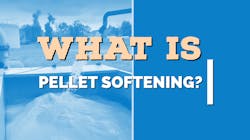Pellet softening vs. lime softening for water plants
What is pellet softening?
Pellet softening is a fluidized bed reactor technology for precipitation-based water softening. It uses caustic soda or lime to raise the pH of the water to create a precipitation reaction to reduce calcium in the water. The chemistry principles behind pellet softening is similar to that of lime softening, which has been traditionally used in drinking water treatment plants.
Pellet softening vs. lime softening
While lime softening and pellet softening use the same chemical reaction to reduce or remove calcium carbonate from the water to achieve water softness, there are a couple notable difference.
Tank differences
Differing from lime softening, pellet softening uses a tall vertical tank filled with filtration media — commonly silica sand — to further encourage the precipitation reaction.
The tank for pellet softening is vertically oriented with a tall column for the precipitation reaction zone in which the silica sand resides. The addition of caustic soda or lime to the water raises the pH to 10 in the reactor, causing the hardness in the water to crystalize and precipitate out. A typical pH for water lies between 6.5 and 8.6.
Lime softening tanks often use clarifiers — typically these are large circular tanks, but some are square or rectangular. Mixers in those tanks mix in lime or soda ash to raise the pH just like pellet softening.
Rather than silica sand for precipitation, however, traditional lime tanks use mechanical scrapers to remove the precipitated hardness which settles at the bottom of the tank. This product is referred to as lime sludge and is pumped out of the system for later disposal.
Sludge residuals vs. pellets
The end product of each process is different. With lime softening, it leaves over what is called lime sludge, but with pellet softening, the hardness is contained in small, hardened pellets.
The lime sludge from a traditional lime plant is then dewatered to create a more solid end product before it is disposed. This requires the use of mechanical equipment such as belt presses, centrifuges or other dewatering solutions. Once dry, it must then be hauled to a landfill for disposal.
With a pellet softener, that dewatering equipment is not needed as the pellets are 98% dewatered within two hours of exiting of the fluizied bed reactor where they are collected in a dewatering hopper or a dewatering bin. As a result the volume of waste hauled for disposal to a landfill is a greater volume of waste product to water.
How are pellet softening pellets used?
The pelletized end product from a pellet softening system can be used regionally throughout the United States as animal feed supplement, or for filling for pipe, trench or construction projects. Additional uses include aggregate for roads construction or
Operating a pellet softener
Traditional lime softening systems that use clarification can turn over 1 to 2 gallons per minute per square foot. Pellet softening, however, can operate as high as 40 gpm per square foot despite a smaller footprint.
Can you retrofit a plant for pellet softening?
Switching to pellet softening from lime softening will require construction, but it can be phased. Because pellet softening has a higher throughput, a drinking water plant can take one clarifier out of service at a time while bringing pellet softeners online to replace the flow.
Due to the increased flow of pellet softeners, in some cases one system can replace the footprint of one clarifier while doing the work of multiple clarifiers. As such, it is possible to take additional clarifiers out of service and reclaim that footprint for other needs at the drinking water plant.
In some cases, the clarifiers taken out of service can be used for water storage or additional chemistry rather than tearing it down and using the space for another purpose.
Alternatives to pellet softening
Lime softening is the most common alternative to pellet softening, but a handful of other technologies are also used.
In addition to pellet and lime softening, water softening solutions include membrane-based technologies such as reverse osmosis or nanofiltration, and resin-based softening such as ion-exchange.
Reverse osmosis and nano-fitration require pretreatment to ensure no fouling of the membranes. Operational costs considerations must be made around that pretreatment equipment and the energy required to pump the water through high pressure membranes.
Ion exchange uses resin to capture the calcium carbonate, which creates a waste stream that must be disposed, an operational cost consideration.
An additional expense to weigh when considering a softening solution includes the replacement of the resin or filtration media.
About the Author
Bob Crossen
Editorial Director
Bob Crossen is the vice president of content strategy for the Water and Energy Groups of Endeavor Business Media, a division of EndeavorB2B. EB2B publishes WaterWorld, Wastewater Digest and Stormwater Solutions in its water portfolio and publishes Oil & Gas Journal, Offshore Magazine, T&D World, EnergyTech and Microgrid Knowledge in its energy portfolio. Crossen graduated from Illinois State University in Dec. 2011 with a Bachelor of Arts in German and a Bachelor of Arts in Journalism. He worked for Campbell Publications, a weekly newspaper company in rural Illinois outside St. Louis for four years as a reporter and regional editor. Crossen can be reached at [email protected].

